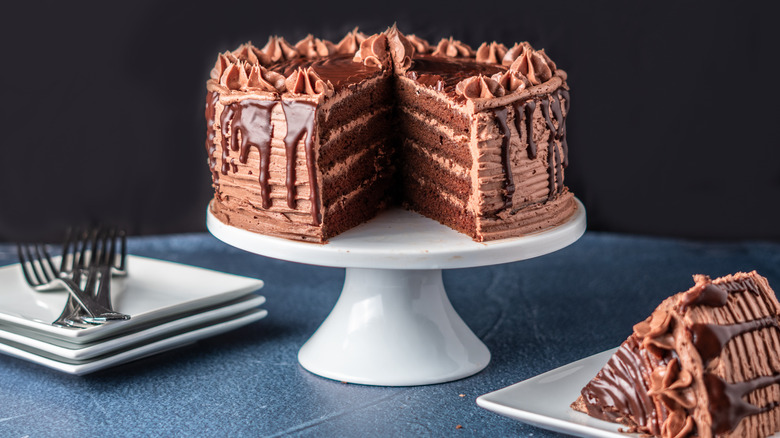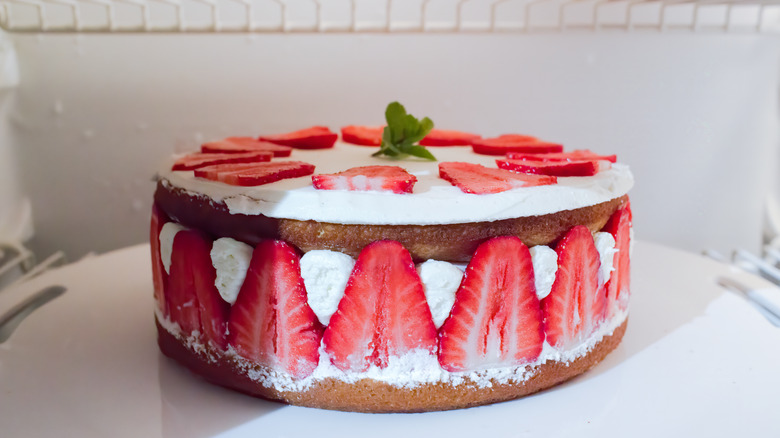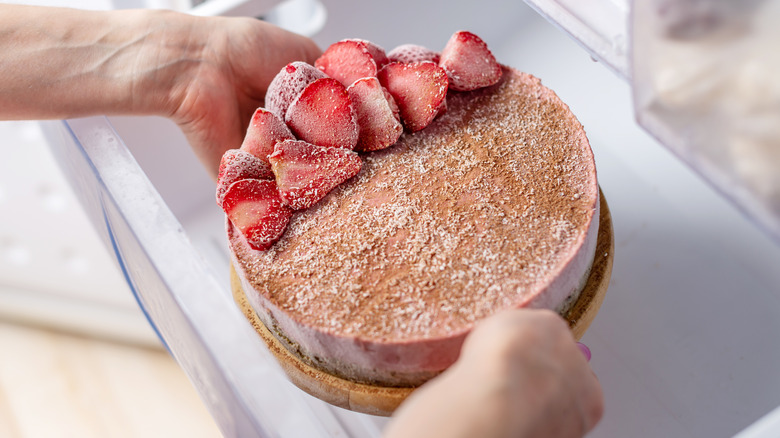Think Twice Before Putting Your Cake Creation In The Fridge
Leftover cake is often sliced into triangles, packed into containers, and placed in the fridge for safekeeping; but have you ever wondered why your dessert doesn't seem to hit the spot the next day? Those buttery-soft and moist slices of cake feel all too dry and crumbly after a while in the cold. As it turns out, cakes rarely fare well in the fridge, and there are better ways to save these confections for later.
Refrigerators are saviors when it comes to perishable items, but in the case of cakes, they can do more harm than good. This is because all goods made with flour contain molecules of starch that absorb liquid when the dough or batter is baked. These starches crystallize and lose water as they cool, which causes a cake's internal moisture to evaporate out of the crumb, leaving a dry and brittle texture in its wake.
Even bread can stale and get hard twice as quickly in the refrigerator, so imagine what it does to a soft and delicate cake. While the staling of a cake is inevitable, refrigeration considerably hastens the process. In most cases, you'll find that leaving the cake at room temperature is one of the best ways for it to retain its tastiness. You'll just have to try and eat it all within three days, for optimal quality.
When to refrigerate a cake
While refrigeration is usually a food storage mistake you should stop making with cakes, there are exceptions to the rule. Simple flour-based sponges made from butter and oil are best kept at room temperature, but cakes layered with whipped cream, cream cheese frosting, buttercream, or other dairy-based components should actually go in the fridge, lest the dairy spoils. The same goes for ones with fresh fruit, compote, and egg-based custards, which will degrade quickly at room temperature. Another exception is fully frosted cakes: Frosting will protect the moist interior, keeping it soft even under cold temperatures.
On the flip side, cakes with frostings and toppings that aren't made with eggs or dairy are fine when kept on the counter, and frosting made from margarine or vegetable shortening can withstand higher heat, making them a safer bet for outside the fridge. However, you still need to keep the temperature of your kitchen in mind.
A range of 60 to 70 degrees Fahrenheit is the ideal temperature for storing cakes, and "room temperature" has a loose definition, but is generally considered to be between 68 to 74 degrees F. If your kitchen is on the above-70 degrees F side of "room temperature," you'll want to refrigerate the cake, no matter what type it is. If your cake qualifies for room temperature storage, either cover it with plastic or transfer it to a container, and keep it in a dry area away from direct heat and sunlight.
For a better texture, consider freezing your cakes
To refrigerate a cake, wrap it in foil or cling film and pack into a container. Leave the lid slightly ajar so that there's enough air circulation for the cake to retain its texture. Stored this way, homemade bakes should stay fresh for about a week, and store-bought ones may last even longer. You also have another option: freeze the confections. Whereas refrigerators cause the water in your cake to evaporate and dries up the crumb, freezers solidify that moisture and lock it in, helping cakes stay just as fresh for as long as three months later. In fact, this is a common practice in bakeries to save time and manage oven space.
The first step to freezing a cake is ensuring that it's fully-cooled — lingering steam can cause bacterial growth later on. From there, plain unfrosted sponges are best wrapped in two layers of cling film plus one layer of aluminum foil. Pop them in a container to prevent freezer burn and then move them to cold storage. The same process goes for sliced cakes and frosted ones, though you'll want to pop the latter into the freezer for an hour or two first before wrapping it in plastic, so the creamy icing solidifies. Transfer the frozen treats to the refrigerator or the counter to let them thaw and regain their softness before you dig into them.



